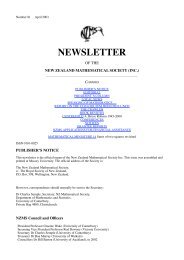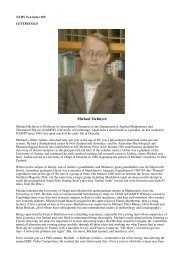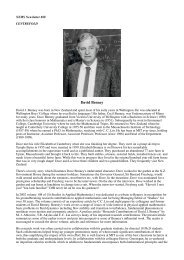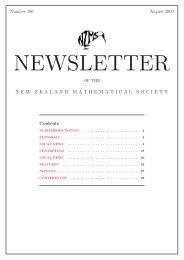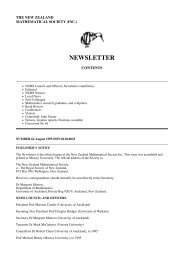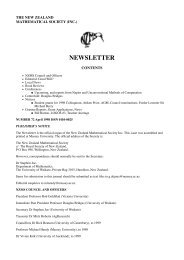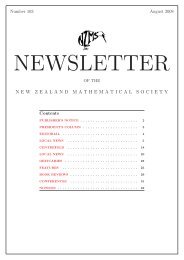newsletter - New Zealand Mathematical Society
newsletter - New Zealand Mathematical Society
newsletter - New Zealand Mathematical Society
You also want an ePaper? Increase the reach of your titles
YUMPU automatically turns print PDFs into web optimized ePapers that Google loves.
Hands-On-Science program for high school students. The focus of the project was on the use of<br />
population models in conservation. As well as considering the practical aspects of models that are used to<br />
help organisations like the Department of Conservation, the students also found out about the<br />
mathematics underlying some of the models. The first day was spent learning about an example of a<br />
population that is in need of conservation: Hector's dolphin. The students got to know something about<br />
where these dolphins live and roughly how many there are. The focus for the rest of the day was on<br />
modelling the number of dolphins in the population that lives around Banks Peninsula. They looked at<br />
simply exponential models, and then those that involve density dependence and stochasticity. This<br />
naturally led on to ideas of chaos and of risk assessment. Later in the week, discussion of chaos led on to<br />
using software to draw fractal images such as SierpinskiÕs Gasket and Barnsley's Fernleaf. Overall, a<br />
good time was had by all!<br />
A MARK workshop sponsored by The Wildlife <strong>Society</strong> Biometrics Working Group. This advanced<br />
workshop was held at Canterbury University, Christchurch, <strong>New</strong> <strong>Zealand</strong>, in December 2003 as part of<br />
the 3rd International Wildlife Congress in Christchurch. Led by Gary White and Richard Barker, the aim<br />
of the workshop was to update experienced MARK users on some of the latest developments in MARK.<br />
Seminars<br />
Dr Michael Bulmer (University of Queensland), "Virtual Worlds for Teaching Mathematics and<br />
Statistics".<br />
Dr Margaret Walshaw (Department of Technology, Science & Mathematics Education, Massey<br />
University), "Explorations of girls and mathematics".<br />
Professor Bruce Reed (McGill University), "1,2,3, C".<br />
John Shanks, "Horner in the Corner".<br />
Richard Barker, "McMC, WinBUGS and the Bayesian rEvolution".<br />
Amal Amleh, "A Basic Introduction to Very Interesting Nonlinear Difference Equations".<br />
THE UNIVERSITY OF WAIKATO<br />
Department of Mathematics<br />
Lenette Grant<br />
The summer break is usually a time for travelling and this was certainly the case for members of the<br />
department. Within <strong>New</strong> <strong>Zealand</strong>, Kevin Broughan and a PhD student Vasile Sinescu attended the<br />
workshop on "Computational Algebra and Number Theory" held in Nelson, while Alfred Sneyd attended<br />
the "Mathematics-in-Industry Study Group" held in Auckland. In early February, Ernie Kalnins and Rua<br />
Murray attended the "Victoria International Conference" held in Wellington.<br />
Ernie was also an international traveller. He spent most of January visiting Linköping University in<br />
Sweden. While there, he gave a talk at the conference on "State of the Art of Classical Separability<br />
Theory for Differential Equations". He then participated in the workshop held directly after the<br />
conference. This workshop was focused on current research problems in separability theory. He also had<br />
the opportunity to give some lectures to students at the university.<br />
Recently appointed lecturer Tim Stokes returned to Australia for two months over summer for a<br />
combination of work and rest. He worked in Melbourne for a fortnight with Marcel Jackson (Latrobe<br />
University) on semigroup theory. Later, he attended the ANZIAM conference in Hobart in early February,<br />
where he presented a talk. In fact he stayed in Hobart for several weeks, mostly working with colleagues<br />
Larry Forbes (University of Tasmania) and Graeme Hocking (visiting from Murdoch University, WA) on<br />
withdrawal problems for free surfaces in fluid mechanics. He reports that the weather was a lot drier in<br />
South-Eastern Australia than in Hamilton on his return!<br />
Sean Oughton spent two weeks at his alma mater, the University of Delaware, where he was collaborating<br />
on magnetohydrodynamic turbulence problems, including applications to the question of why the sun's<br />
atmosphere is so much hotter than its surface. Solar heat in Delaware, however, was rather lacking. The<br />
visit coincided with an unusually cold winter period with typical daytime temperatures of -10C.<br />
In March Ian Craig spent a week at the Yukawa Institute of Kyoto University when he gave an invited<br />
review talk on magnetic reconnection as part of the workshop on "Explosive Phenomena in Magnetized<br />
Plasmas—<strong>New</strong> Developments in Reconnection Research".




